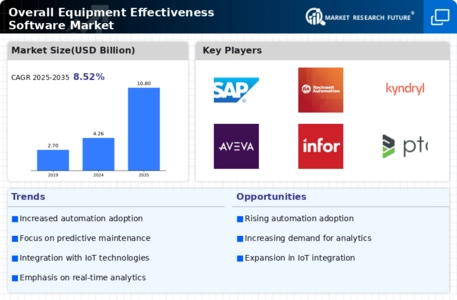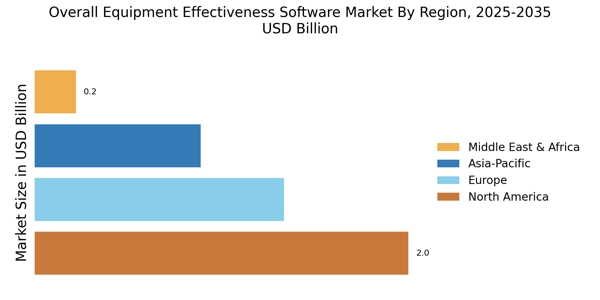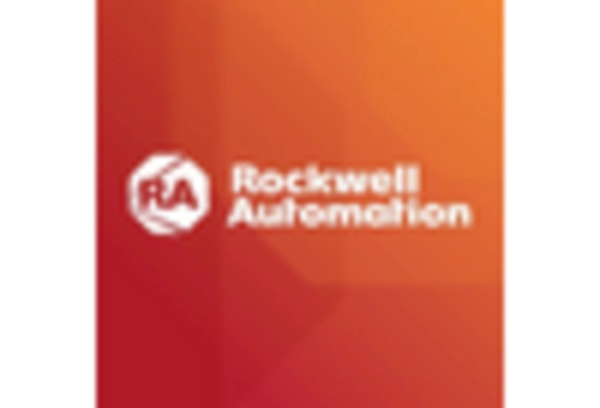Integration of IoT Technologies
The integration of Internet of Things (IoT) technologies is significantly influencing the Overall Equipment Effectiveness Software Market Industry. IoT devices enable real-time monitoring and data collection from machinery, which enhances the capabilities of OEE software. This integration allows for more accurate tracking of equipment performance and predictive maintenance, potentially reducing unplanned downtime by up to 30%. As industries increasingly adopt IoT solutions, the demand for OEE software that can seamlessly integrate with these technologies is likely to grow. This trend reflects a broader movement towards smart manufacturing, where data-driven insights lead to more informed decision-making. The synergy between IoT and OEE software is expected to drive innovation and create new opportunities within the market.
Rising Demand for Operational Efficiency
The Overall Equipment Effectiveness Software Market Industry is experiencing a surge in demand as organizations strive for enhanced operational efficiency. Companies are increasingly recognizing the importance of optimizing equipment performance to reduce downtime and improve productivity. According to recent data, organizations that implement OEE software can achieve up to a 20% increase in productivity. This trend is driven by the need to remain competitive in a rapidly evolving market, where efficiency directly correlates with profitability. As industries face pressure to maximize output while minimizing costs, the adoption of OEE software becomes a strategic imperative. This driver indicates a broader shift towards performance optimization, suggesting that businesses are willing to invest in technology that provides measurable improvements in their operational processes.
Advancements in Data Analytics Capabilities
Advancements in data analytics capabilities are reshaping the Overall Equipment Effectiveness Software Market Industry. The ability to analyze vast amounts of data generated by manufacturing processes allows organizations to gain deeper insights into equipment performance. Enhanced analytics tools enable predictive maintenance, which can lead to a reduction in maintenance costs by up to 25%. As businesses increasingly rely on data-driven decision-making, the demand for OEE software equipped with advanced analytics features is likely to rise. This trend indicates a shift towards more sophisticated software solutions that not only track performance but also provide actionable insights. The evolution of data analytics within the OEE software market suggests a promising future for organizations seeking to leverage data for operational excellence.
Focus on Sustainability and Waste Reduction
Sustainability has emerged as a critical focus for many organizations, influencing the Overall Equipment Effectiveness Software Market Industry. Companies are increasingly seeking ways to minimize waste and reduce their environmental footprint. OEE software plays a vital role in this endeavor by providing insights into equipment efficiency and identifying areas for improvement. By optimizing processes, organizations can reduce energy consumption and material waste, aligning with sustainability goals. Recent studies indicate that companies utilizing OEE software can achieve a reduction in waste by approximately 15%. This driver highlights the growing recognition of the importance of sustainable practices in manufacturing and production, suggesting that OEE software will be integral to achieving these objectives.
Regulatory Compliance and Quality Standards
The need for regulatory compliance and adherence to quality standards is a significant driver in the Overall Equipment Effectiveness Software Market Industry. As industries face increasing scrutiny from regulatory bodies, the demand for software that ensures compliance with safety and quality standards is rising. OEE software assists organizations in maintaining high-quality production processes by providing real-time data and analytics. This capability enables companies to quickly identify and rectify issues that may lead to non-compliance. Furthermore, industries such as pharmaceuticals and food processing are particularly affected by stringent regulations, making OEE software essential for maintaining compliance. This driver suggests that the intersection of regulatory requirements and operational efficiency will continue to shape the market landscape.


















Leave a Comment